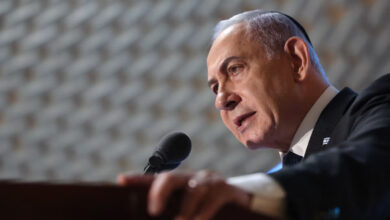Cairenes have been rattled out of their seats for two consecutive days by an armed forces air show to commemorate the October War against Israel in 1973.
Low-flying F-16 fighter jets swooped over downtown Cairo on Tuesday and Wednesday.
6 October has always witnessed an unleashing of nationalist sentiment in the form of jingoistic songs accompanying grainy black-and-white images of soldiers on the frontline. The state media has always used the day to lionize the men who served in the war, with particular emphasis given to one man, Hosni Mubarak, who, so the narrative goes, led the first air attack on Israeli troops.
For the first time in over 30 years, Mubarak is conspicuously absent this year, and his Minister of Defense Hussein Tantawy, who now heads of the Supreme Council of Armed Forces (SCAF), is presiding over proceedings.
This year’s celebrations have a verve and intensity absent from recent years; while there have previously been flyovers, this is the first time in recent history that Cairenes have been subjected to a two-day (and likely three-day) marathon display of air force prowess involving smoke trails – inexplicably colored red, white and blue.
The choice of colors raised questions about whether the display was for Egyptians, or for Leon Panetta, the US Secretary of Defense, currently visiting Egypt.
Sitting in a tiny tailor's shop in central Cairo, Sayed Abdel-Salam and Magdy Shohby, both 56 years old, had very different explanations of what the air display was about.
“It took me back to the old days,” Abdel-Salam said wistfully before describing how as a child he collected toys and sweets dropped over the Ain Seera area of Cairo by military planes.
“The display raises morale,” he continued.
“Come over here and let me tell you the real reason behind it,” Shohby shouted.
Shohby presented his thesis. The air display, he said, was meant to “terrorize citizens.”
“The sound was huge and frightening. We’ve just come out of a revolution. Why are you terrorizing us?”
Unlike his friend Sayed, Shohby only had unhappy associations with the jet’s terrific noise.
He said the planes reminded him of the time when two F-16s buzzed protesters in Tahrir Square on 30 January 2011, and of the helicopter that for days circled downtown Cairo.
No one ever knew what was the function of the two F16s, flying at a very low altitude over protesters on strike in Tahrir Square; narratives ranged from the military surveilling the square to an attempt to frighten protesters.
Ali Metwally, an employee in a Tahrir Square bag store has a different view. He thinks that while the air show was meant to send a message, it wasn’t aimed at Egyptian citizens.
“This is a message that the military is still here and still strong. It was a display of force and we were happy to see it. It’s a good feeling to know that your country has aircraft of this type capable of making this noise,” Metwally said.
Whatever the reason behind the display, what is not in contention is that it was costly and paid for out of the massive and secret military budget, at a time when economists and politicians have repeatedly warned that the economy is on the verge of collapse.
An anonymous military source said that there were about 100 planes used for the show, including F16s, Mirage jet fighters, K8s and Megs.
One American national who works in Egypt as a technician fixing the equipment imported from the US – and who requested anonymity – told Al-Masry Al-Youm English that an F-16 costs somewhere between $10,000 and $20,000 per hour to run, depending on factors such as how long it remains in the hangar before and after the flight, and the price of fuel.
With these estimates, three days of flying three jets for an hour each day would cost between $90,000 and $180,000.
Additional reporting by Abdel-Rahman Hussein and Steven Viney




